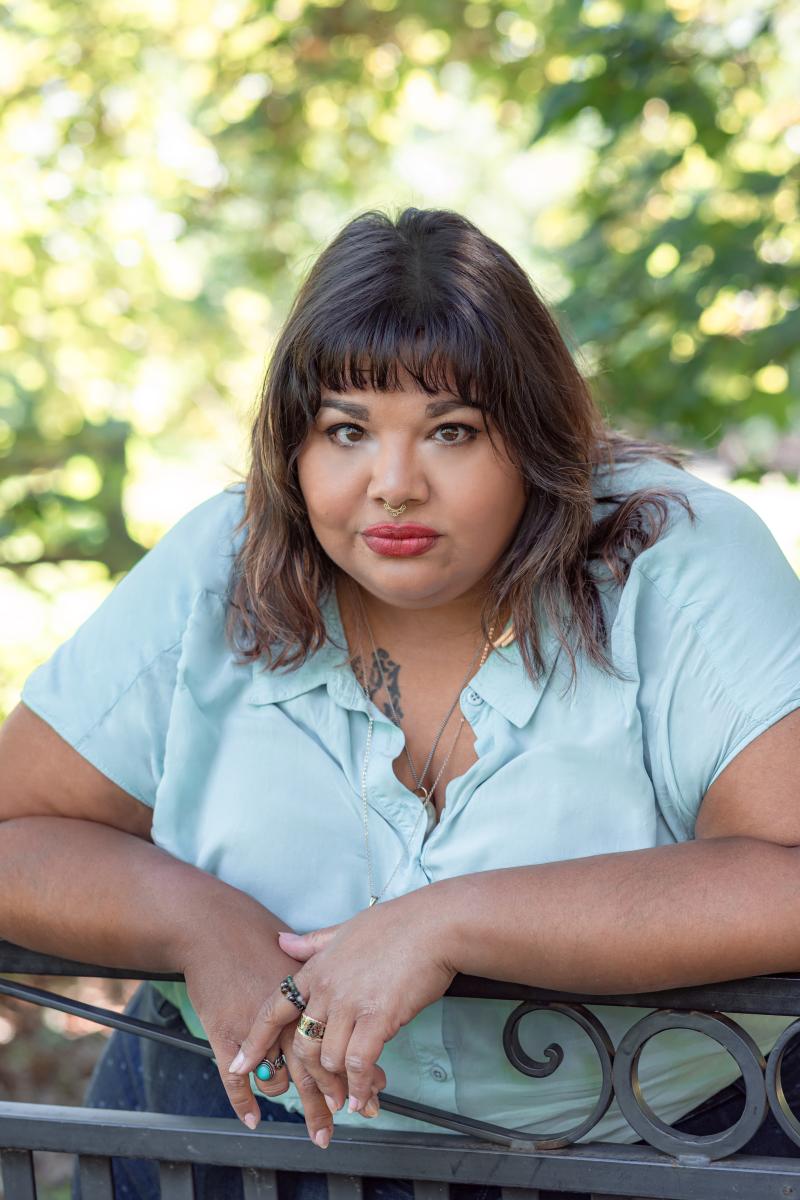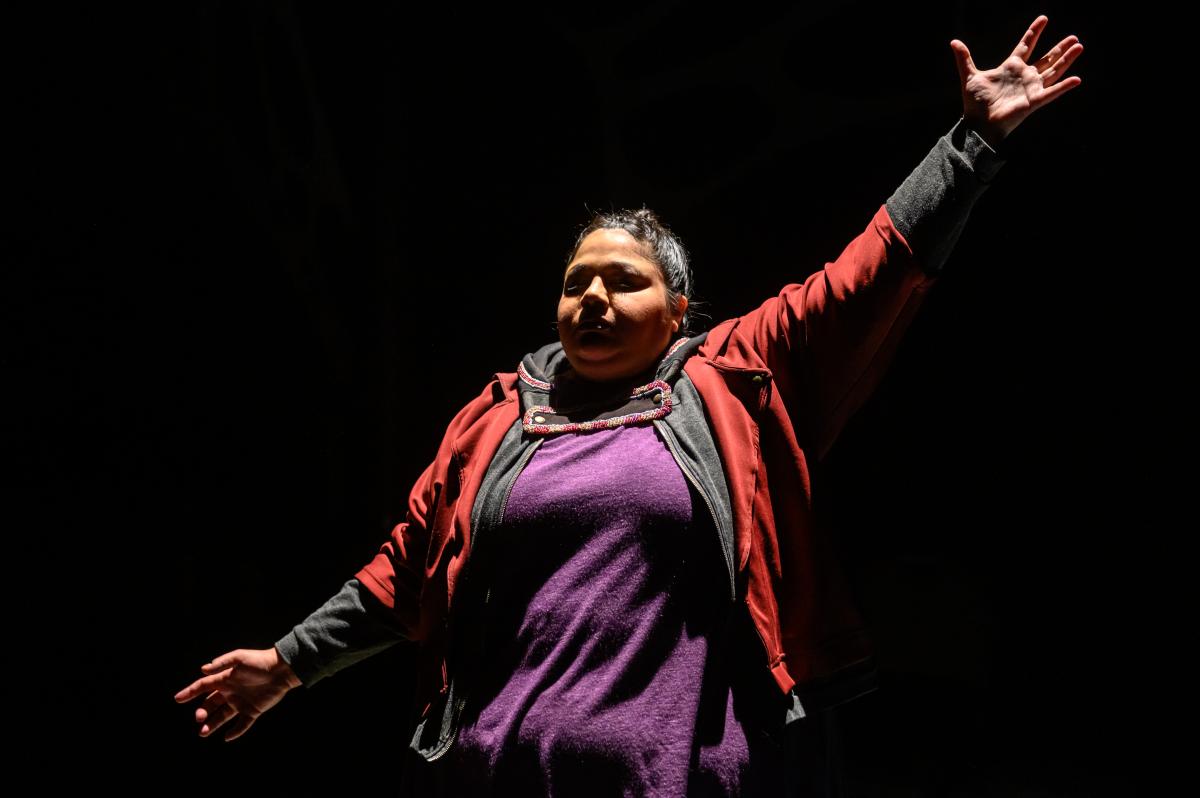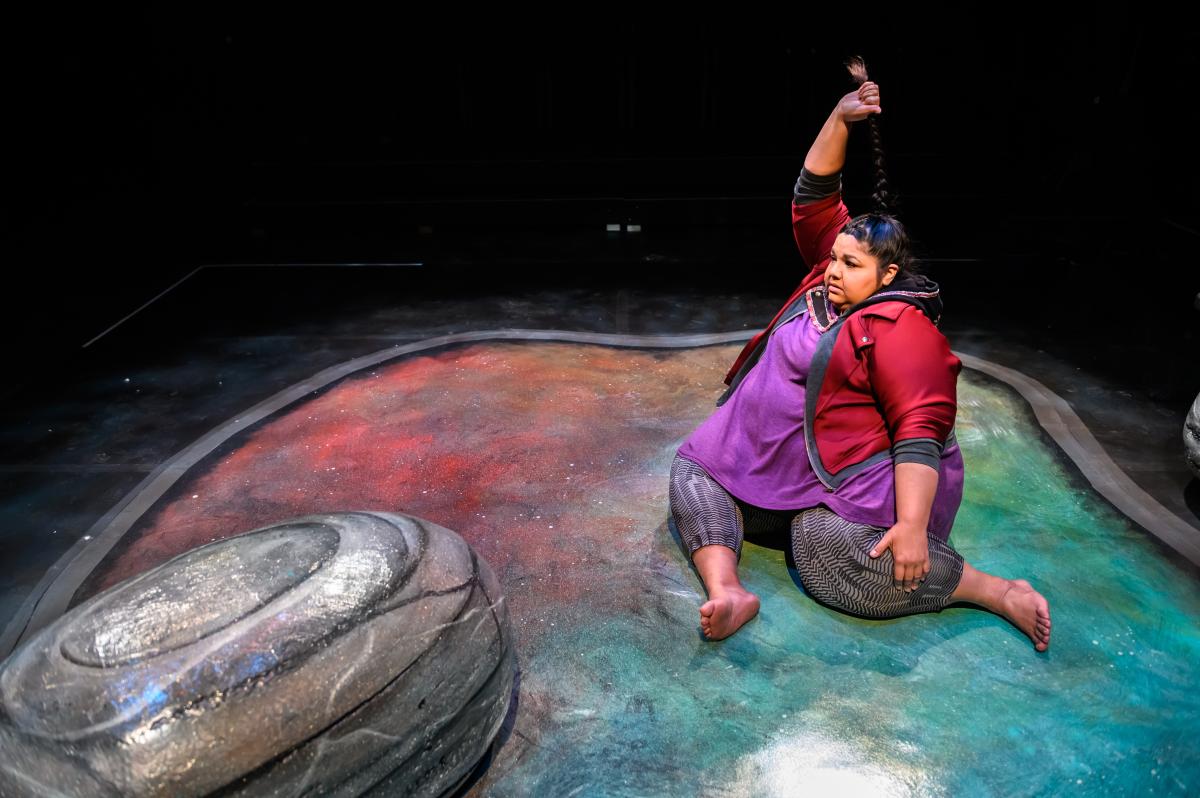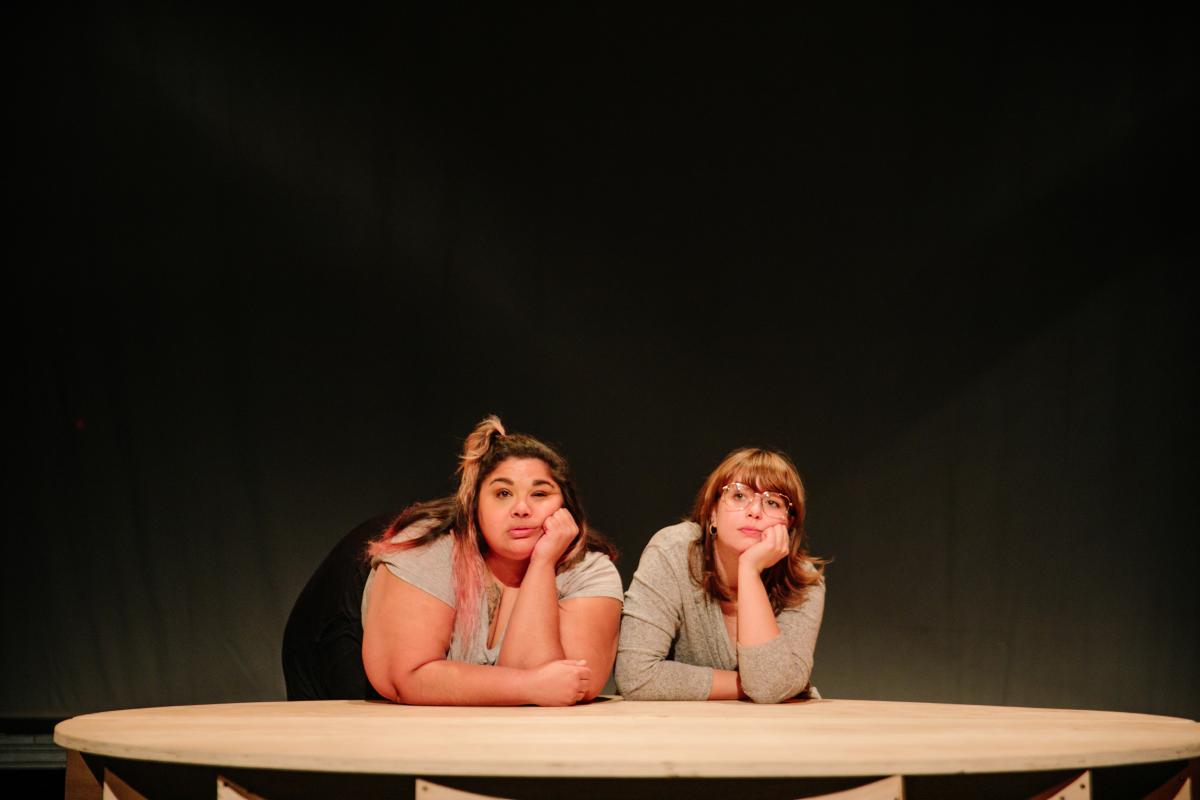June 3, 2024
Started in 2018, the Indigenous Artist Spotlight series is intended to foster greater awareness and understanding of the strength and diversity of Indigenous art available in Ontario and beyond. Find all of our past Spotlight interviews here. This month, we spoke with Yolanda M. Bonnell.

Yolanda Bonnell (They/She) is a Bi/Pan/Queer 2 Spirit Anishinaabe-Ojibwe, South Asian mixed-race storyteller and multidisciplinary creator/educator. Hailing from Fort William First Nation, Ontario their arts practice is now based in Tkarón:to where they are co-artistic leader of manidoons collective, that they run with Michif (Métis) artist, Cole Alvis. In February 2020, Yolanda’s four-time Dora nominated solo piece bug was remounted at Theatre Passe Muraille while the published play was shortlisted for a Governor General’s Literary Award. In 2022, their published work, White Girls in Moccasins, was produced at Buddies in Bad Times Theatre as well as at the frank theatre on Coast Salish Territory. Yolanda was the first Indigenous artist recipient of the Jayu Arts for Human Rights Award and won the Playwright’s Guild of Canada Tom Hendry Drama Award for My Sister’s Rage which was produced by Tarragon Theatre in 2022. Yolanda, who has just completed her first full length young adult novel has also taught/facilitated classes and workshops at schools like York University, Sheridan College and with Studio 180 Theatre. She proudly bases her arts practice in land-based creation and Anishinaabe methodologies, using care as a base, working towards disability justice in theatre.
Please take a moment to introduce yourself to our audience for those who may not know you.
Aanii! Yolanda Bonnell nindizhinikaaz. My name is Yolanda Bonnell, my spirit name is Gizhibaa M’yiingan. I am Bear clan on my great grandfather’s side and Eagle clan on my great grandmother’s. I am an Ojibwe citizen of the Anishinaabeg Nation originally from Fort William First Nation near Thunder Bay, Ontario but myself and my arts practice are now based in Tkarón:to. I call myself a sovereign storyteller as it encapsulates the various roles I take on in the creative industry (writing, performing, directing, producing, facilitating/teaching) and I work hard to approach my practice with Anishinaabek methodologies, values and disability justice.
You are the co-artistic lead of the manidoons collective, a producing circle of Indigenous artists who work to implement Indigenous methodologies into theatre spaces. Could you speak to why this work is important and how the collective’s work has manifested since it was formed in 2016?
I think that any work that centres care for the human beings that are doing the work is incredibly important. I believe that we have a responsibility to each other in the theatre community (and beyond) to hold compassion because actors, designers, producers are not machines - we are humans. However, because the arts are, unfortunately, a capitalistic industry, they don’t typically make space for that compassion - particularly for racialized artists. Cole Alvis and I recognized this pretty quickly and we immediately began to work differently from what we were taught. Partially because it just felt like the right thing to do - make space to check in with each other, build relation and ease into the work. We also learned a lot from working with community members, other artists and from our own experiences. Over time, the practice grew to include hiring healers as active listeners, building accessibility measures into as many aspects of the work as we can, providing sustenance and gentle space. Of course we made mistakes along the way and we’re still learning and growing and finding what works. It would be disingenuous to say that harm will never happen or that it’s a perfect science. It’s not about being perfect, it’s about the trying of it all. It’s about asking ourselves, what can we do to mitigate the amount of harm that could happen?
And the stories don’t suffer along the way - we can still make beautiful theatre without overworking or harming our communities.
 Your two part play, The Eighth Fire series, traces the migration of Anishinaabek people as part of the 7 Fires prophecy. Could you tell us a bit about the series, what inspired you to create this project and what comes next for this work?
Your two part play, The Eighth Fire series, traces the migration of Anishinaabek people as part of the 7 Fires prophecy. Could you tell us a bit about the series, what inspired you to create this project and what comes next for this work?
The Eighth Fire series came from a commission pitch request from Nightwood Theatre - they were looking for large scope projects and I had been thinking about the idea of prophecy for a while - how there are so many Indigenous nation specific prophecies and many have come true. There was also something about me unearthing more Anishinaabek knowledge about my family’s ancestral history. I was working with Elder Pauline Shirt - who very sadly passed away - and she gifted me with the The Mishomis Book: The Voice of the Ojibwe by Edward Benton Banai which has stories and teachings as well as the 7 Fires Prophecy - which is a migration prophecy. The prophecy itself was found on a wigwas (birchbark) scroll, was translated and this book - I think - is one of the only places it’s actually written down in English.
So all of this inspired me to start writing this play about this prophecy that told the Anishinaabek - who were living in the east at the time - to ‘move or they would be destroyed’ as a light-skinned race was coming. I wanted to also venture into the future to see how we could end with hope to light the Eighth Fire which is a fire of peace - to me, the fire of sovereignty. I eventually realised that it was too much to fit into one play so it became a two part series. Part One: The Great Migration follows the Anishinaabek from the eastern doorway to the shores of “Lake Superior” in the time of colonial impact of the fifth fire. We also meet their future ancestors; activists who are fighting for change and love.
Part Two: Bagosinem/Have Hope picks up where part one leaves off. The Anishinaabek people are now in the sixth fire, where they are struggling to deal with the impacts of colonialism. Meanwhile in the time ahead, communities are at the precipice of sovereignty and revolution.
I’ve been fortunate enough to receive funding for some workshops. I have a large workshop coming up that will feature a reading of part one and two in Tkarón:to and then we’ll be doing the readings in St. Catherine’s for Suitcase in Point’s In the Soil Arts Festival.

Your play bug was nominated for 4 Dora’s and the published version was shortlisted for a Governor General’s Literary Award. Could you share a bit about thework and any future plans you have for this piece? Has there been an impact on your career since your new accolade or is it life as usual?
bug started as a 15-minute piece that I created for theatre school that sort of took on a life of its own after I graduated. It was largely developed while it was being produced in festivals and on tour. The story means a lot to me for so many reasons. Mostly because of how it connected me with so many Indigenous communities across northern Turtle Island (“canada”). manidoons collective - whose name was created from the character in the play - set up the tours so that we were building relations with the local Indigenous community by doing workshops with women and youth and hiring local healers and liaisons for each stop. Witnesses/audience members really responded positively to the story across the board. Many saw themselves, their loved ones and experiences in it. I think that response rippled out and absolutely had an effect on my career by piquing the industry’s interest in my work. I also feel that the request manidoons collective made to the media about hiring racialized critics for bug sort of solidified my status as a disruptor more than anything else.
There are no current plans for it, but I would love to remount it with another Indigenous actor in the role.
 Is there anything else that you would like to share? Do you have any upcoming work that we should look out for?
Is there anything else that you would like to share? Do you have any upcoming work that we should look out for?
I encourage all artists to continue to challenge the systems of oppression and ableism that are upheld in the theatre industry. There are safer and more humane ways to tell the stories that reflect so much of our humanity. They need to be explored and invested in.
In terms of upcoming work - My Sister’s Rage is published in the latest edition of Staging Coyote’s Dream being released soon.
Both bug and my play White Girls in Moccasins are published and available online and in stores.
You can catch the public reads of the Eighth Fire Series at the In the Soil Arts Festival.
Keep up with Yolanda M. Bonnell
- Official Website:https://yolandabonnell.com/
- Facebook: https://www.facebook.com/profile.php?id=100009049460511
- Instagram: https://www.instagram.com/yobiwankenobe/

